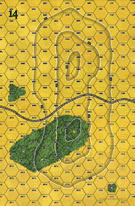|
Assault Iron Curtain #14 |
||
|---|---|---|
| (Attacker) United States | vs | Soviet Union (Defender) |
| Formations Involved | ||
|---|---|---|
| Soviet Union |  |
26th "Vitebskaya" Guards Mechanized Division |
| United States |  |
746th Tank Battalion |
| United States |  |
9th "Old Reliables" Infantry Division |

| Total | |
|---|---|
| Side 1 | 1 |
| Draw | 0 |
| Side 2 | 0 |
| Overall Rating, 1 vote |
|---|
|
3
|
| Scenario Rank: --- of 913 |
| Parent Game | Iron Curtain |
|---|---|
| Historicity | Alt-History |
| Date | 1949-03-01 |
| Start Time | 06:00 |
| Turn Count | 24 |
| Visibility | Day |
| Counters | 72 |
| Net Morale | 0 |
| Net Initiative | 2 |
| Maps | 2: 1, 14 |
| Layout Dimensions | 43 x 28 cm 17 x 11 in |
| Play Bounty | 147 |
| AAR Bounty | 171 |
| Total Plays | 1 |
| Total AARs | 1 |
| Battle Types |
|---|
| Hill Control |
| Road Control |
| Rural Assault |
| Conditions |
|---|
| Entrenchments |
| Off-board Artillery |
| Smoke |
| Scenario Requirements & Playability | |
|---|---|
| Airborne - IE | Counters |
| Battle of the Bulge | Counters |
| Eastern Front | Maps |
| Iron Curtain | Base Game |
| Road to Berlin | Maps + Counters |
| Introduction |
|---|
|
The German "Westwall" defenses made an impression on the U.S. Army's planners, who realized that their M4 Sherman tank could not force its way past powerful anti-tank guns set in thick reinforced concrete. In the fashion typical of bureaucracies everywhere, they responded with an "assault tank" designed to extreme requirements: armored and armed like a land battleship, with the speed to match. |
| Conclusion |
|---|
|
One running example of the T28 (the M28's test version) still exists at the Patton Museum in Fort Know, Kentucky. A massive vehicle with double sets of treads, it would have presented an interesting tactical challenge for both sides in any conflict. But the mobile combat that probably would have taken place in a "hot" Cold War, the T28 was unlikely to be used as designed. |
| AFV Rules Pertaining to this Scenario's Order of Battle |
|---|
|
| Assault on the Hilltop | ||||||||||||
|---|---|---|---|---|---|---|---|---|---|---|---|---|
Setup: The Soviets spread their forces all along the road hexes on the hilltop on Board 14, and setup another line alone the 60-meter hexes in the north, with only a couple of units in the south to stop any American incursions on the southern side of the hills. Play: The Americans move in two forces towards the Soviets' line, aiming to defeat the Soviets' line in the northern heights, before a complete attack across the length of the road. Because of the slow mobility of the Americans, they do not arrive at the base of the hill for ten turns. Soon after, the Americans start up the hills. The smaller group moves along the road to keep the Soviets in position on the road. The Americans slam into the light defenses in the north, and immediately assault, due to the fact they wasted two and a half hours of advancing. The Soviets put up a stiff resistance for the 60-meter hexes in the north. The Americans finally kick out the Soviets from the hill and launch their main attack against the Soviets on the road. The Americans rapidly split the Soviet force in two and begin to whittle away the Soviet force, but only manage to push the Soviets off of the eastern half of the hill. On the western half of the hill the Americans involve themselves in a bitter assault, which lasts until the game ends almost two hours later. Result: American Minor Victory. The Victory Point Count stands at 55-63, with the Americans having a eight point lead. |
||||||||||||
| 0 Comments |

 IrCu013
IrCu013 






















